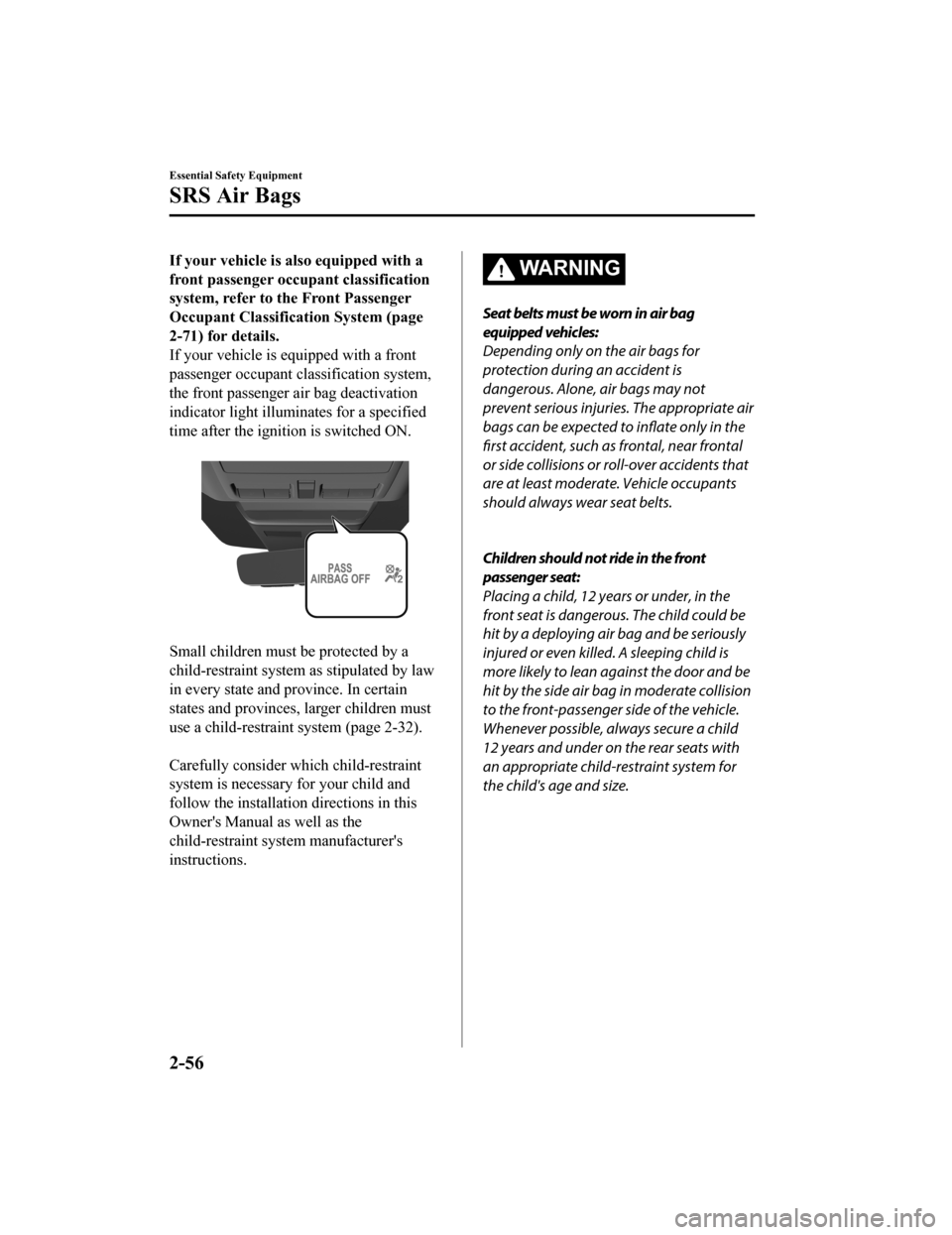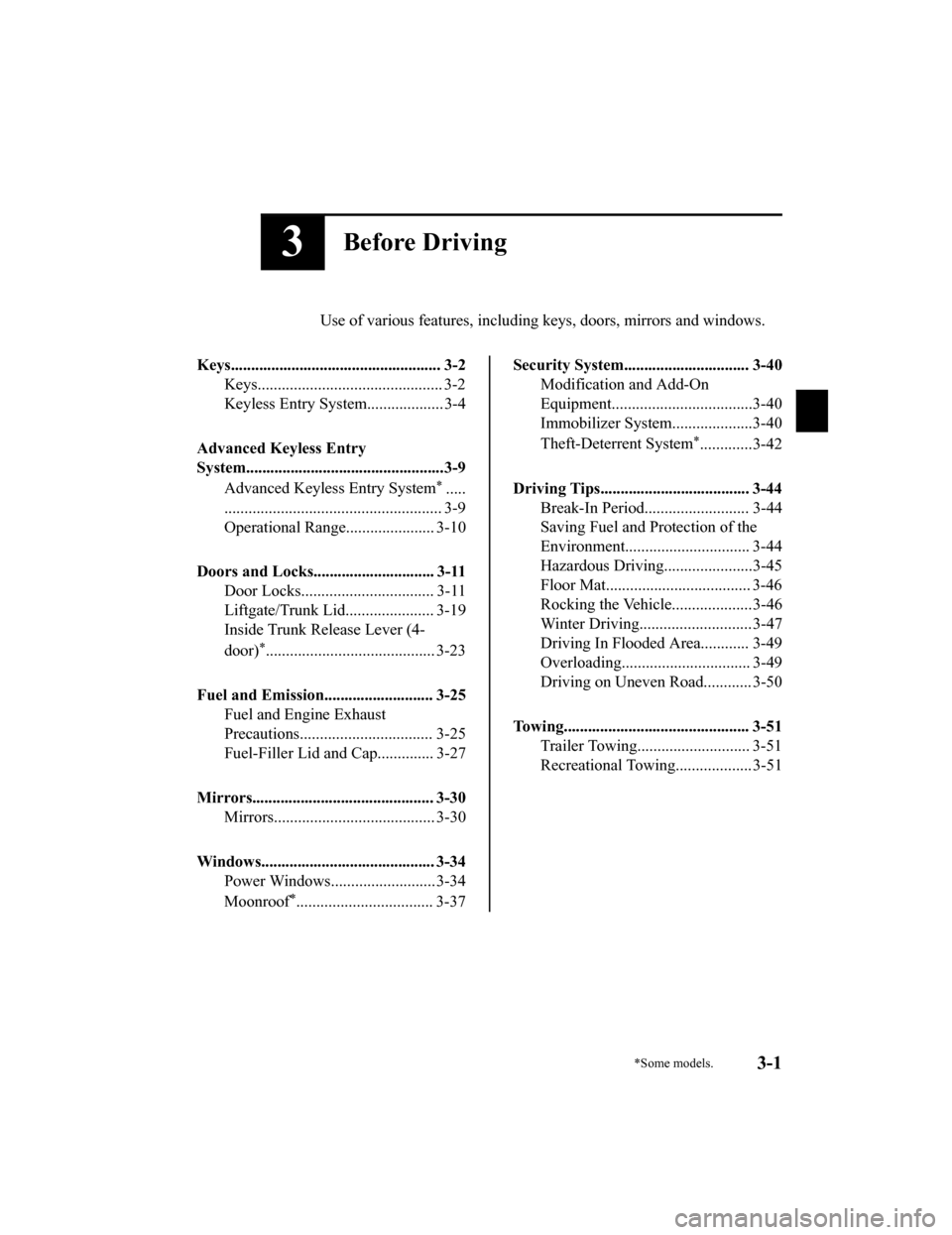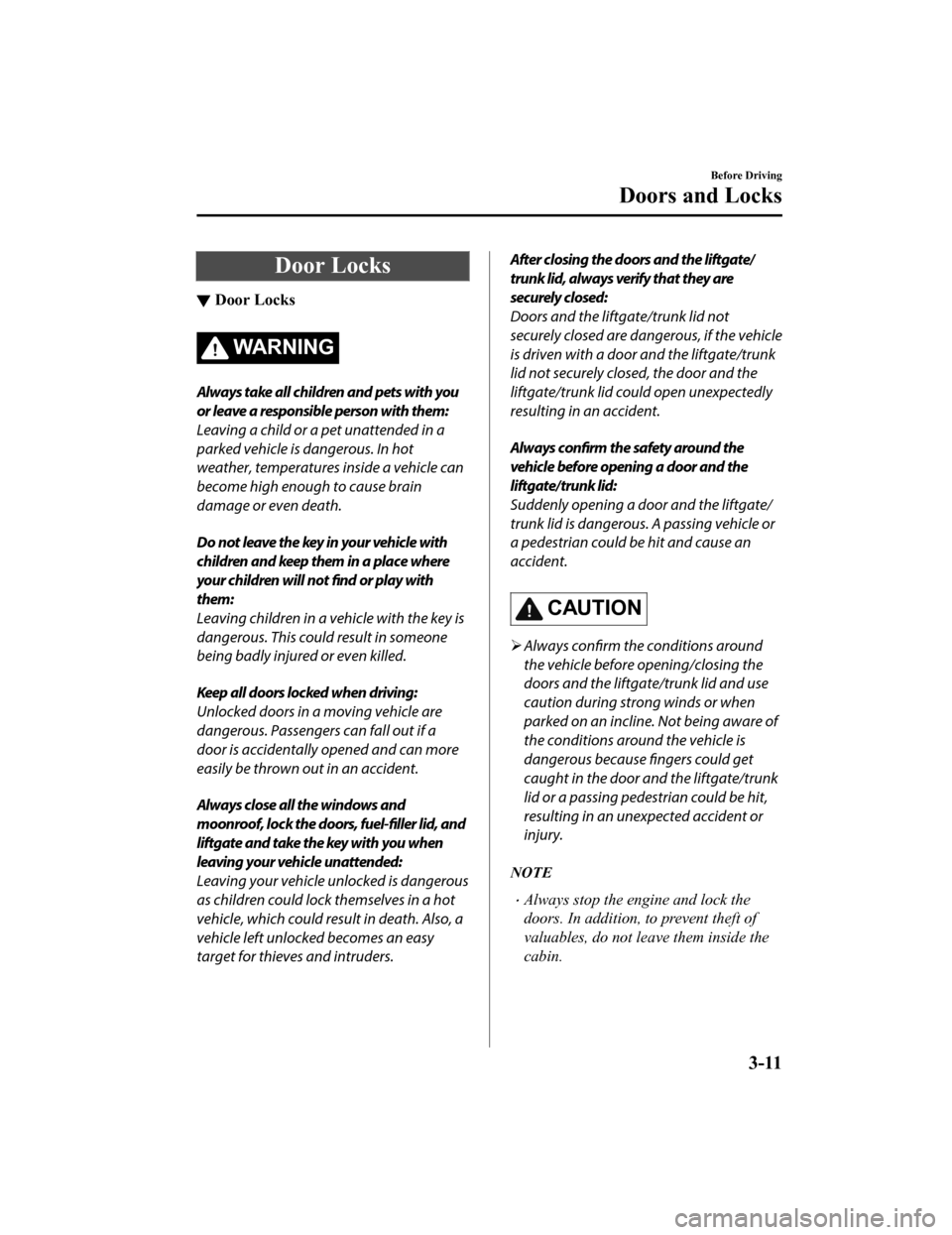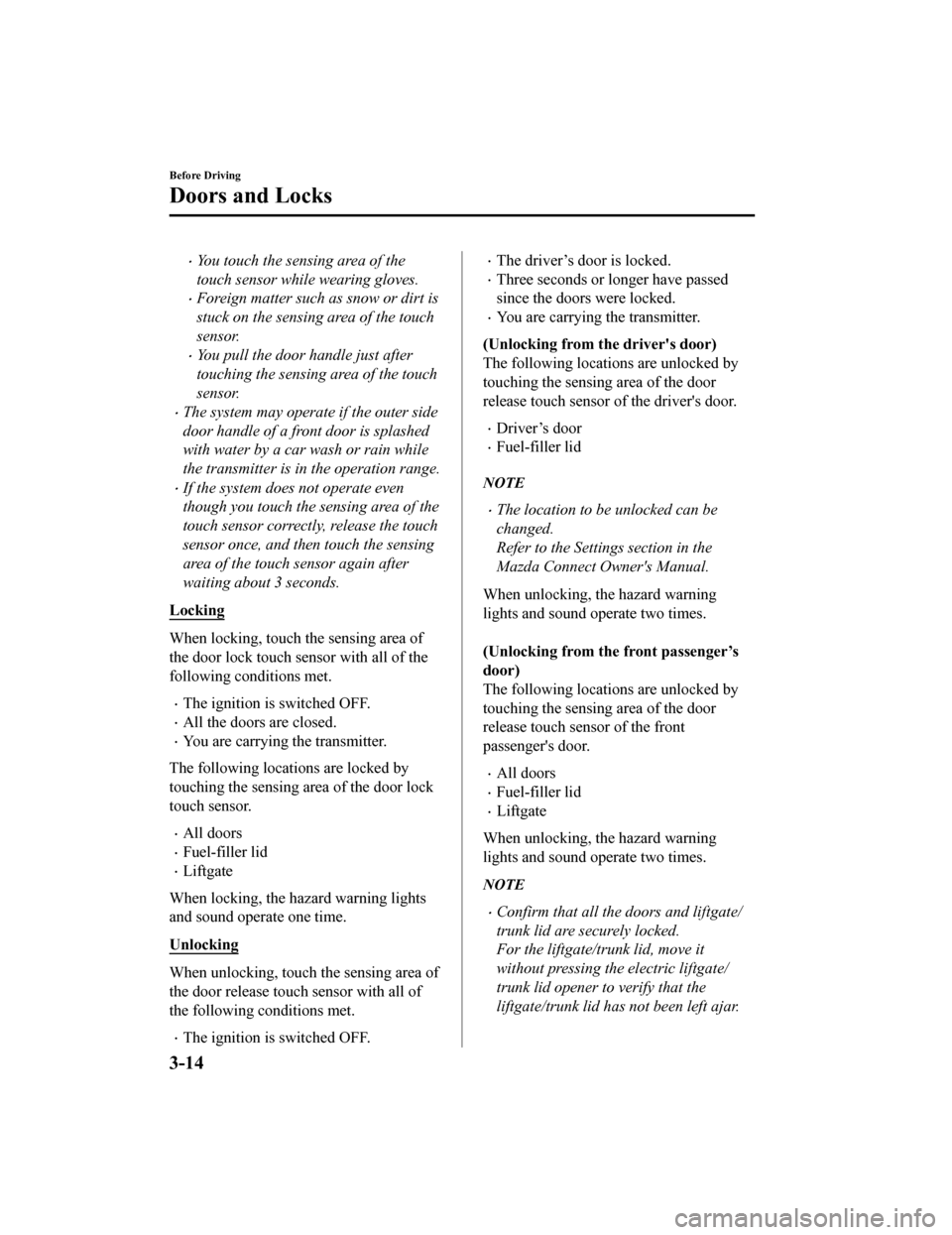ECU MAZDA MODEL 3 HATCHBACK 2020 (in English) Owner's Manual
[x] Cancel search | Manufacturer: MAZDA, Model Year: 2020, Model line: MODEL 3 HATCHBACK, Model: MAZDA MODEL 3 HATCHBACK 2020Pages: 598, PDF Size: 89.37 MB
Page 67 of 598

Never attach two child-restraint systems to
the same ISOFIX/LATCH
*1 lower anchor:
Attaching two child-restraint systems to
the same ISOFIX/LATCH
*1 lower anchor is
dangerous. In a collision, one anchor may
not be strong enough to hold two
child-restraint system attachments, and it
may break, causing serious injury or death.
If you use the seat position for another
child-restraint system when an outboard
ISOFIX/LATCH
*1 position is occupied, use
the center seat belts instead, and the tether
if tether-equipped.
Make sure the child-restraint system is
properly secured:
An unsecured child-restraint system is
dangerous. In a sudden stop or a collision it
could move causing serious injury or death
to the child or other occupants. Follow the
child-restraint system manufacturer's
instructions on belt routing to secure the
seat just as you would with a child in it so
that nobody is tempted to put a child in an
improperly secured seat later on. When not
in use, remove it from the vehicle or fasten
it with a seat belt, or attach it to BOTH
ISOFIX/LATCH
*1 lower anchors for ISOFIX/
LATCH
*1 child-restraint systems.
Make sure there are no seat belts or foreign
objects near or around the ISOFIX/LATCH
*1
child-restraint system:
Not following the child-restraint system
manufacturer's instructions when
installing the child-restraint system is
dangerous. If seat belts or a foreign object
prevent the child-restraint system from
being securely attached to the ISOFIX/
LATCH
*1 lower anchors and the
child-restraint system is installed
improperly, the child-re straint system could
move in a sudden stop or collision causing
serious injury or death to the child or other
occupants. When installing the
child-restraint system, make sure there are
no seat belts or foreign objects near or
around the ISOFIX/LATCH
*1 lower anchors.
Always follow the child-restraint system
manufacturer's instructions.
*1 ISOFIX (Mexico)/LATCH (Except Mexico)
Installation on rear outboard seats
1. First, adjust the front seat to allow clearance between the child-restraint
system and the front seat.
Refer to Adjusting the Driver's Seat on
page 2-5.
Refer to Adjusting the Front
Passenger's Seat on page 2-13.
2. Make sure the seatback is securely
latched by pushing it back until it is
fully locked.
Essential Safety Equipment
Child Restraint
2-51
Mazda3_8HZ1-EA-19G_Edition1_old 2019-5-17 13:49:03
Page 68 of 598

3. Remove the cover of the child-restraintsystem's ISOFIX/LATCH
*1 lower
anchors to verify the locations of the
ISOFIX/LATCH
*1 lower anchors.
1. Lower anchor
NOTE
The ISOFIX/LATCH*1 lower
anchors marking on the cover
indicates the positi on of the ISOFIX/
LATCH
*1 lower anchors for the
attachment of a child-restraint
system.
Store the removed cover so that it
does not get lost.
4. Remove the head restraint. However,
when installing a backless booster seat,
always install the vehicle head restraint
to the seat where the backless booster
seat is installed.
Refer to Head Restra ints on page 2-17.
5. Secure the child-restraint system using
BOTH ISOFIX/LATCH
*1 lower
anchors, following the child-restraint
system manufacturer's instruction. Pull
on the child-restrain t to be sure both
anchors are engaged.
6. If your child-restraint system came equipped with a tether, that means it is
very important to properly secure the
tether for child safety. Please carefully
follow the child-restraint system
manufacturer's instructions when
installing tethers.
*1 ISOFIX (Mexico)/LATCH (ExceptMexico)
WA R N I N G
Use the tether and tether anchor only for a
child-restraint system:
Using the tether or tether anchor to secure
anything but a child-restraint system is
dangerous. This could weaken or damage
the tether or tether anchor and result in
injury.
Always remove the head restraint and
install child-restraint system (except when
installing a backless booster seat):
Installing a child-restraint system without
removing the head restraint is dangerous.
The child-restraint system cannot be
installed correctly which may result in
death or injury to the child in a collision.
(4–Door)
1. Tether strap
Essential Safety Equipment
Child Restraint
2-52
Mazda3_8HZ1-EA-19G_Edition1_old 2019-5-17 13:49:03
Page 72 of 598

If your vehicle is also equipped with a
front passenger occupant classification
system, refer to the Front Passenger
Occupant Classification System (page
2-71) for details.
If your vehicle is equipped with a front
passenger occupant classification system,
the front passenger air bag deactivation
indicator light illuminates for a specified
time after the ignition is switched ON.
Small children must be protected by a
child-restraint system as stipulated by law
in every state and province. In certain
states and provinces, larger children must
use a child-restraint system (page 2-32).
Carefully consider wh ich child-restraint
system is necessary for your child and
follow the installation directions in this
Owner's Manual as well as the
child-restraint syst em manufacturer's
instructions.
WA R N I N G
Seat belts must be worn in air bag
equipped vehicles:
Depending only on the air bags for
protection during an accident is
dangerous. Alone, air bags may not
prevent serious injuries. The appropriate air
bags can be expected to inflate only in the
first accident, such as frontal, near frontal
or side collisions or roll-over accidents that
are at least moderate. Vehicle occupants
should always wear seat belts.
Children should not ride in the front
passenger seat:
Placing a child, 12 years or under, in the
front seat is dangerous. The child could be
hit by a deploying air bag and be seriously
injured or even killed. A sleeping child is
more likely to lean against the door and be
hit by the side air bag in moderate collision
to the front-passenger side of the vehicle.
Whenever possible, always secure a child
12 years and under on the rear seats with
an appropriate child-restraint system for
the child's age and size.
Essential Safety Equipment
SRS Air Bags
2-56
Mazda3_8HZ1-EA-19G_Edition1_old 2019-5-17 13:49:03
Page 91 of 598

A rear passenger steps on the front
passenger seat rails with their feet.
Luggage or other items are placed on the
seatback or hung on the head restraint.
Heavy items are placed in the seatback
map pocket.
The seat is washed.
Liquids are spilled on the seat.
The front passenger seat is moved
backward, pushing into luggage or other
items placed behind it.
The front passenger seatback contacts
the rear seat.
Luggage or other items are placed
between the front passenger seat and
driver seat.
Any accessories which might increase the
total seated weight on the front
passenger seat are attached to the front
passenger seat.
CAUTION
To assure proper deployment of the front
air bag and to prevent damage to the
sensors in the front seat bottoms:
Do not place sharp objects on the front
seat bottoms or leave heavy luggage
on them.
Do not spill any liquids on the front
seats or under the front seats.
To allow the sensors to function properly,
always perform the following:
Adjust the front seats as far back as
possible and always sit upright against
the seatbacks with seat belts worn
properly.
If you place your child on the front
passenger seat, secure the
child-restraint system properly and
slide the front passenger seat as far
back as possible (page 2-47).
NOTE
The system requires about 10 seconds to
alternate between turning the front
passenger front and side air bags and
knee air bags, and seat belt pretensioner
system on or off.
The front passenger air bag deactivation
indicator light may illuminate
repeatedly if luggage or other items are
put on the front passenger seat, or if the
temperature of the vehicle's interior
changes suddenly.
The front passenger air bag deactivation
indicator light may illuminate for 10
seconds if the total seated weight on the
front passenger seat changes.
The air bag/front seat belt pretensioner
system warning light might illuminate if
the front passenger seat receives a
severe impact.
If the front passenger air bag
deactivation indicator light does not
illuminate after installing a
child-restraint system on the front
passenger seat, first, re-install your
child-restraint system according to the
procedure in this owner's manual. Then,
if the front passenger air bag
deactivation indicator light still does not
illuminate, install the child-restraint
system on the rear seat and consult an
Authorized Mazda Dealer as soon as
possible.
Essential Safety Equipment
SRS Air Bags
2-75
Mazda3_8HZ1-EA-19G_Edition1_old 2019-5-17 13:49:03
Page 92 of 598

If the front passenger air bag
deactivation indicator light illuminates
when an adult is seated in the front
passenger seat, have the passenger
re-adjust their posture by sitting with
their feet on the floor, and then
re-fastening the seat belt. If the front
passenger air bag deactivation indicator
light still illuminates, move the
passenger to the rear seat. If sitting in
the rear seat is not possible, slide the
front passenger seat as far back as
possible. Consult an Authorized Mazda
Dealer as soon as possible.
▼Driver and Front Passenger Buckle
Switches
The buckle switches on the front seat belts
detect whether or not the front seat belts
are securely fastened and further control
the deployment of the air bags.
Constant Monitoring
▼ Constant Monitoring
The following componen
ts of the air bag
systems are monitored by a diagnostic
system:
Front air bag sensors
Crash sensors, and diagnostic module
(SAS unit)
Side crash sensors
Air bag modules
Front seat belt pretensioners
Air bag/Front seat belt pretensioner
system warning indi cation/warning light
Related wiring
(With Driver and Front Passenger
Occupant Classifi cation System)
Driver seat slide position sensor
Front passenger occupant classification
sensor
Front passenger occupant classification
module
Front passenger air bag deactivation
indicator light
Front passenger seat belt buckle switch
The diagnostic module continuously
monitors the system's readiness. This
begins when the igni tion is switched ON
and continues while the vehicle is being
driven.
Essential Safety Equipment
SRS Air Bags
2-76
Mazda3_8HZ1-EA-19G_Edition1_old 2019-5-17 13:49:03
Page 93 of 598

3Before Driving
Use of various features, including keys, doors, mirrors and windows.
Keys.................................................... 3-2 Keys.............................................. 3-2
Keyless Entry System................... 3-4
Advanced Keyless Entry
System.................................................3-9 Advanced Keyless Entry System
*.....
...................................................... 3-9
Operational Range...................... 3-10
Doors and Locks.............................. 3-11 Door Locks................................. 3-11
Liftgate/Trunk Lid...................... 3-19
Inside Trunk Release Lever (4-
door)
*.......................................... 3-23
Fuel and Emission........................... 3-25 Fuel and Engine Exhaust
Precautions................................. 3-25
Fuel-Filler Lid and Cap.............. 3-27
Mirrors............................................. 3-30 Mirrors........................................ 3-30
Windows........................................... 3-34 Power Windows..........................3-34
Moonroof
*.................................. 3-37
Security System............................... 3-40Modification and Add-On
Equipment...................................3-40
Immobilizer System....................3-40
Theft-Deterrent System
*.............3-42
Driving Tips..................................... 3-44 Break-In Period.......................... 3-44
Saving Fuel and Protection of the
Environment............................... 3-44
Hazardous Driving.... ..................3-45
Floor Mat.................................... 3-46
Rocking the Vehicle....................3-46
Winter Driving............................3-47
Driving In Flooded A rea............ 3-49
Overloading................................ 3-49
Driving on Uneven Road............ 3-50
Towing.............................................. 3-51 Trailer Towing............................ 3-51
Recreational Towing................... 3-51
*Some models.3-1
Mazda3_8HZ1-EA-19G_Edition1_old 2019-5-17 13:49:03
Page 103 of 598

Door Locks
▼Door Locks
WA R N I N G
Always take all children and pets with you
or leave a responsible person with them:
Leaving a child or a pet unattended in a
parked vehicle is dangerous. In hot
weather, temperatures inside a vehicle can
become high enough to cause brain
damage or even death.
Do not leave the key in your vehicle with
children and keep them in a place where
your children will not find or play with
them:
Leaving children in a vehicle with the key is
dangerous. This could result in someone
being badly injured or even killed.
Keep all doors locked when driving:
Unlocked doors in a moving vehicle are
dangerous. Passengers can fall out if a
door is accidentally opened and can more
easily be thrown out in an accident.
Always close all the windows and
moonroof, lock the doors, fuel-filler lid, and
liftgate and take the key with you when
leaving your vehicle unattended:
Leaving your vehicle unlocked is dangerous
as children could lock themselves in a hot
vehicle, which could result in death. Also, a
vehicle left unlocked becomes an easy
target for thieves and intruders.
After closing the doors and the liftgate/
trunk lid, always verify that they are
securely closed:
Doors and the liftgate/trunk lid not
securely closed are dangerous, if the vehicle
is driven with a door and the liftgate/trunk
lid not securely closed, the door and the
liftgate/trunk lid could open unexpectedly
resulting in an accident.
Always confirm the safety around the
vehicle before opening a door and the
liftgate/trunk lid:
Suddenly opening a door and the liftgate/
trunk lid is dangerous. A passing vehicle or
a pedestrian could be hit and cause an
accident.
CAUTION
Always confirm the conditions around
the vehicle before opening/closing the
doors and the liftgate/trunk lid and use
caution during strong winds or when
parked on an incline. Not being aware of
the conditions around the vehicle is
dangerous because fingers could get
caught in the door and the liftgate/trunk
lid or a passing pedestrian could be hit,
resulting in an unexpected accident or
injury.
NOTE
Always stop the engine and lock the
doors. In addition, to prevent theft of
valuables, do not leave them inside the
cabin.
Before Driving
Doors and Locks
3-11
Mazda3_8HZ1-EA-19G_Edition1_old 2019-5-17 13:49:03
Page 105 of 598

▼Unlocking with Auxiliary Key
Only the driver's door can be unlocked
using the auxiliary key.
Refer to Keys on page 3-2.
Insert the auxiliary key while the driver's
door handle is pulled and turn the key to
the unlock side. Turn the auxiliary key
back to its original position before
removing it.
NOTE
If you attempt to open the driver’s door
using an unauthorized auxiliary key, the
key cylinder will spin around but the door
will not unlock.
▼Locking, Unlocking with Touch
Sensor, Door Handle (With the
advanced keyless function)
By touching the sensing area of the touch
sensor, various locking/unlocking
operations can be done without taking the
key out of a bag or pocket.
There are two types of touch sensors used
for locking and unlocking, and each sensor
is built into the outer door handle on the
driver and front passenger's doors.
1. Sensing area of door lock touch sensor
(Depression on outer side of door
handle)
2. Sensing area of door release touch sensor (Inner side of door handle)
NOTE
When locking/unlocking with the
transmitter carried, securely touch the
sensing area of the touch sensor as
follows.
Locking
Unlocking
The system may not operate normally
under the following conditions.
You touch the sensing area of the door
lock touch sensor and the sensing
area of the door release touch sensor
at the same time.
Before Driving
Doors and Locks
3-13
Mazda3_8HZ1-EA-19G_Edition1_old 2019-5-17 13:49:03
Page 106 of 598

You touch the sensing area of the
touch sensor while wearing gloves.
Foreign matter such as snow or dirt is
stuck on the sensing area of the touch
sensor.
You pull the door handle just after
touching the sensing area of the touch
sensor.
The system may operate if the outer side
door handle of a front door is splashed
with water by a car wash or rain while
the transmitter is in the operation range.
If the system does not operate even
though you touch the sensing area of the
touch sensor correctly, release the touch
sensor once, and then touch the sensing
area of the touch sensor again after
waiting about 3 seconds.
Locking
When locking, touch the sensing area of
the door lock touch sensor with all of the
following conditions met.
The ignition is switched OFF.
All the doors are closed.
You are carrying the transmitter.
The following locations are locked by
touching the sensing area of the door lock
touch sensor.
All doors
Fuel-filler lid
Liftgate
When locking, the hazard warning lights
and sound operate one time.
Unlocking
When unlocking, touch the sensing area of
the door release touch sensor with all of
the following conditions met.
The ignition is switched OFF.
The driver’s door is locked.
Three seconds or longer have passed
since the doors were locked.
You are carrying the transmitter.
(Unlocking from the driver's door)
The following locations are unlocked by
touching the sensing area of the door
release touch sensor of the driver's door.
Driver’s door
Fuel-filler lid
NOTE
The location to be unlocked can be
changed.
Refer to the Settings section in the
Mazda Connect Owner's Manual.
When unlocking, the hazard warning
lights and sound operate two times.
(Unlocking from the front passenger’s
door)
The following locations are unlocked by
touching the sensing area of the door
release touch sensor of the front
passenger's door.
All doors
Fuel-filler lid
Liftgate
When unlocking, the hazard warning
lights and sound operate two times.
NOTE
Confirm that all the doors and liftgate/
trunk lid are securely locked.
For the liftgate/trunk lid, move it
without pressing the electric liftgate/
trunk lid opener to verify that the
liftgate/trunk lid has not been left ajar.
Before Driving
Doors and Locks
3-14
Mazda3_8HZ1-EA-19G_Edition1_old 2019-5-17 13:49:03
Page 111 of 598

Liftgate/Trunk Lid
▼Liftgate/Trunk Lid
WA R N I N G
Never allow a person to ride in the luggage
compartment/trunk:
Allowing a person to ride in the luggage
compartment/trunk is dangerous. The
person in the luggage compartment/trunk
could be seriously injured or killed during
sudden braking or a collision.
Do not drive with the liftgate/trunk lid
open:
Exhaust gas in the cabin of a vehicle is
dangerous. An open liftgate/trunk lid in a
moving vehicle will cause exhaust gas to be
drawn into the cabin. This gas contains CO
(carbon monoxide), which is colorless,
odorless, and highly poisonous, and it can
cause loss of consciousness and death.
Moreover, an open lift
gate/trunk lid could
cause occupants to fall out in an accident.
Do not stack or leave loaded luggage
unsecured in the luggage compartment:
Otherwise, the luggage may move or
collapse, resulting in injury or an accident.
In addition, do not load luggage higher
than the seatbacks. It may affect the side or
rear field of view.
CAUTION
Before opening the liftgate/trunk lid,
remove any snow and ice accumulation
on it. Otherwise, the liftgate/trunk lid
could close under the weight of the snow
and ice resulting in injury.
Be careful when opening/closing the
liftgate/trunk lid during strong winds. If a
strong gust blows against the liftgate/
trunk lid, it could close suddenly resulting
in injury.
Fully open the liftgate/trunk lid and
make sure that it stays open. If the
liftgate/trunk lid is only opened partially,
it could slam shut by vibration or wind
gusts resulting in injury.
When loading or unloading luggage in
the luggage compartm ent/trunk, turn off
the engine. Otherwise, you could get
burned by the heat of the exhaust gas.
Be careful not to apply excessive force to
the damper stay on the liftgate such as
by putting your hand on the stay.
Otherwise, the damper stay may bend
and
affect the liftgate operation.
1. Damper stay
Before Driving
Doors and Locks
3-19
Mazda3_8HZ1-EA-19G_Edition1_old
2019-5-17 13:49:03